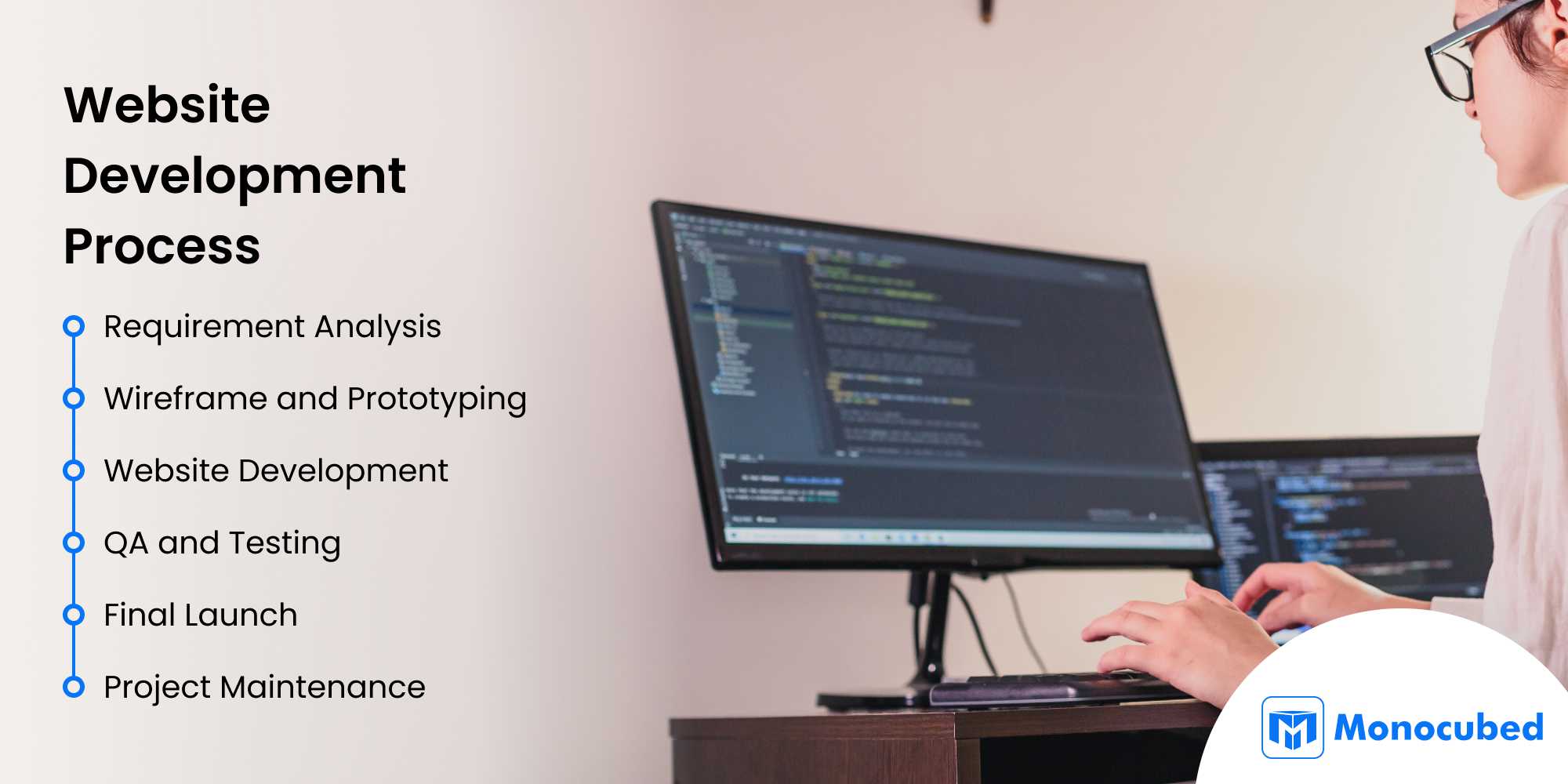Your competitor just launched a stunning website. Meanwhile, you’re stuck choosing between web developers who either promise the world for $5,000 or quote $30,000 without any clear explanations.
It’s happening not because you hired bad web developers, but because you haven’t fully understood the website development process before signing a contract.
With over 2 billion websites worldwide and the web development market valued at USD 76.27 billion in 2025, projected to reach USD 165.13 billion by 2035 at a CAGR of 8.03% according to Business Research Insights. This makes understanding professional website development processes essential for project success.
As a leading website development company, Monocubed has completed 200+ projects using our 6-phase of website development process and created this guide to help you navigate each development stage successfully.
In this guide, you’ll learn:
✅ The 6 essential phases of professional website development
✅ Technologies and tools used by professional agencies
✅ Website development cost
✅ How to hire the right website development partner
By following these insights, you’ll be able to plan, execute, and launch a website that not only meets your business goals but also delivers a seamless experience for your users.
Table of Contents
- Phase 1: Requirement Analysis – Building the Foundation
- Phase 2: Wireframe and Website Design – Visualizing Your Vision
- Phase 3: Website Development – Building Your Digital Asset
- Phase 4: Testing and Quality Assurance – Ensuring Flawless Performance
- Phase 5: Server Setup and Final Website Launch
- Phase 6: Ongoing Maintenance – Protecting Your Investment
- Website Development Cost Breakdown by Type
- Transform Your Vision Into a High-Performing Website
- Frequently Asked Questions
Phase 1: Requirement Analysis – Building the Foundation
The first phase of the website development process is requirement analysis, which determines project success or failure. Professional website development agencies invest significant time understanding your business before touching design or code.
It’s the most critical stage to start the web development that website developers often skip, leading to costly rework later.
So, what happens during requirement analysis?
Business and goal discovery
During this initial step to make a website, you need to explore your business model, revenue drivers, target audience, competitive landscape, and how your website supports overall objectives.
It also includes stakeholder interviews, competitive analysis, target audience research, current website audit (if applicable), and business goals documentation with measurable KPIs that guide the entire website designing and development journey.
Technology stack selection
Whether you are focusing on ecommerce website development or just want to learn the process for simple website creation, selecting the right tech stack is crucial for project success.
Technology stack selection for modern websites:
| Category | Technologies | Best Used For |
|---|---|---|
| Frontend | React.js, Next.js, Vue.js, Angular | Dynamic interfaces, SEO-optimized pages, enterprise applications |
| Backend | Node.js, PHP (Laravel), Python (Django), Ruby on Rails | Server-side logic, APIs, database operations, business workflows |
| CMS Platforms | WordPress, Contentful, Strapi, Webflow | Content management, easy updates, marketing flexibility |
| Databases | PostgreSQL, MySQL, MongoDB, Redis | Data storage, user information, product catalogs, caching |
| Hosting | AWS, Google Cloud, Microsoft Azure, DigitalOcean | Cloud infrastructure, scalability, reliability, global reach |
Timeline and budget planning
Professional websites require 4-12 weeks for standard business sites and 12-16+ weeks for complex applications. A trusted web development team establishes realistic timelines with clear milestones, dependencies, and deliverables as part of the structured website development phases.
Budget planning includes development costs, third-party services, hosting, SSL certificates, ongoing maintenance, and optional enhancements. Expert web developers help prioritize features using the MoSCoW framework (Must have, Should have, Could have, Won’t have), ensuring core functionality launches within budget.
Legal protections and agreements
An experienced web development company provides comprehensive contracts and Non-Disclosure Agreements (NDAs) protecting your business concepts and proprietary information. At Monocubed, complete confidentiality is standard practice for every client engagement throughout the website production cycle.
With your requirements clearly documented and a web development strategy defined, you’re ready to move into the exciting visual design phase where your website begins to take shape.
Want to Develop a Website With Proper Planning?
Get a free requirement analysis consultation with Monocubed. We’ll help you define clear requirements, realistic timelines, and accurate budgets.
Phase 2: Wireframe and Website Design – Visualizing Your Vision
The website design phase transforms requirements into concrete visuals you can see and evaluate. This critical stage in the website design and development process directly impacts your business results.
According to VWO’s 2025 research, well-executed UI design increases conversions by 200%, while superior UX design boosts conversions by 400%. Design directly impacts your bottom line.
Information architecture and sitemap
Information architecture defines how content is organized, labeled, and accessed on your website. This foundational step of website production determines whether users find what they need quickly or leave frustrated.
- Content hierarchy: Organizing information into logical categories
- Navigation structure: Defining primary, secondary, and footer navigation
- User flow mapping: Documenting paths users take to accomplish goals
- URL structure: Planning clean, SEO-friendly URLs
Professional information architecture includes:
Creating sitemaps provides a bird’s-eye view of your website, showing relationships between pages and helping identify gaps or redundancies in content organization. Thus, it makes an essential element in the web design development workflow.
Wireframing essentials
Before investing in high-fidelity design, web developers create wireframes, simplified blueprints showing page structure, content organization, and navigation without final styling. This web designing approach follows proven steps of website development that enable rapid iteration when changes are inexpensive.
Professional wireframing tools:
| Tool | Best For | Key Features |
|---|---|---|
| Figma | Collaboration & prototyping | Real-time collaboration, component libraries, developer handoff |
| Adobe XD | Adobe ecosystem users | Auto-animate, voice prototyping, Adobe integration |
| Sketch | Mac-based teams | Vector editing, team libraries, extensive plugins |
| Balsamiq | Rapid sketching | 500+ premade components, quick wireframe creation |
Visual design and UI development
Once wireframes are approved, website designers create high-fidelity mockups incorporating your brand identity, color schemes, typography, imagery, and overall aesthetic.
-
Professional website design considers:
- Visual hierarchy: It includes using size, color, and contrast to guide attention
- Color psychology: Selecting colors that evoke appropriate emotions
- Typography: Choosing readable, accessible, on-brand font combinations
- Brand consistency: Ensuring alignment with existing brand guidelines
- White space: Using negative space strategically for focus and breathing room
Mobile-first responsive design
With 63% of global web traffic from mobile devices, this phase of the website design process involves designing mobile-first following modern web development steps, then enhanced for tablets and desktops. Responsive web design means your website automatically adapts layout, navigation, images, and functionality based on screen size.
User experience optimization
Professional UX design focuses on how websites work from the user’s perspective during the website designing and development phase. It includes:
- User flow mapping – Documenting paths to accomplish goals
- Conversion optimization – Placing CTAs strategically and removing friction
- Navigation design – Creating intuitive menu structures
- Accessibility compliance – Ensuring WCAG 2.1 AA standards are met
- Page-loading speed – Designing with page speed in mind (2.5 seconds or less)
Interactive prototypes simulate website functionality before development begins, allowing you to test workflows and catch usability issues when they’re cheap to fix. This step is also a crucial checkpoint in the website redesign process and helps ensure your website is built efficiently and user-friendly from the start.
Now that your design is approved and validated through prototypes, it’s time to transform these static visuals into a fully functional, interactive website through the development phase.
Phase 3: Website Development – Building Your Digital Asset
This development phase is where the stages of website development shift from visual planning to technical execution. This technical phase requires expertise in multiple programming languages, frameworks, databases, and integrations, representing the core of the website development process.
Frontend development: What users see
Frontend developers build user-facing experiences using modern technologies that power the interactive elements of your website:
| Core Technologies | HTML5, CSS3, JavaScript |
|---|---|
| Modern Frameworks | React.js, Vue.js, Angular, Next.js |
Front-end web developers ensure pixel-perfect implementation, cross-browser compatibility (Chrome, Firefox, Safari), and performance optimization through image compression, code minification, and lazy loading.
Backend development – What powers functionality
Backend developers build invisible infrastructure including server-side logic, database operations, user authentication, payment processing, and third-party integrations that form the backbone of the web development process.
| Programming Languages | Node.js, Python, PHP, Ruby, Java |
|---|---|
| Databases | PostgreSQL, MySQL, MongoDB, Redis |
| API Development | RESTful APIs, GraphQL |
CMS integration and content management
Content management systems empower your team to update content without developer assistance. a key component of sustainable website production:
- WordPress – Powers 43% of websites, extensive plugin ecosystem
- Contentful – API-first headless CMS for omnichannel content
- Strapi – Open-source headless CMS with customization flexibility
- Sanity – Real-time collaborative content platform
Security implementation
Professional development includes comprehensive security measures essential to the website development life cycle:
- SSL/TLS certificates – Encrypted connections (required for payment processing)
- Input validation – Preventing SQL injection and XSS attacks
- Secure authentication – Password hashing with bcrypt or Argon2
- HTTPS enforcement – Redirecting all traffic to secure connections
- Regular security updates – Patching vulnerabilities in dependencies
- Compliance features – Meeting GDPR, CCPA, or industry-specific regulations
Version control and CI/CD
Hired web developers use Git for version control, enabling multiple developers to work simultaneously, tracking all changes, and maintaining complete project history throughout the website development stages.
Continuous Integration/Continuous Deployment (CI/CD) pipelines automate testing and deployment using tools like Jenkins, GitHub Actions, GitLab CI, or CircleCI, ensuring new code doesn’t break existing functionality.
With your website now fully developed and functional, the next critical phase ensures everything works flawlessly. Let’s move to the next phases of website development.
Phase 4: Testing and Quality Assurance – Ensuring Flawless Performance
Quality assurance and website testing represents a crucial checkpoint in the website development process steps. It includes catching bugs, regular performance check, and usability problems before website users encounter them.
Comprehensive testing methodology
This phase of the web development process involves multiple testing approaches to ensure comprehensive quality:
- Functional Testing: Ensures forms, user authentication, payments, search, and interactive elements work as intended.
- Cross-Browser Testing: Verifies consistent performance across Chrome, Firefox, Safari, Edge, and Samsung Internet.
- Responsive Design Testing: Validates layouts on smartphones, tablets, and desktops in both portrait and landscape orientations.
- Performance Testing: Optimizes speed and stability by monitoring page load times, TTFB, LCP, FID, and CLS.
Monocubed has years of experience in delivering websites with high-quality codebases and after rigorous testing. The testing process involves optimizing images, minimizing code, implementing caching strategies, using Content Delivery Networks (CDNs), and eliminating bottlenecks.
Deep security testing
Security testing is essential to protecting your website and user data from potential threats. Professional agencies conduct comprehensive security audits to identify vulnerabilities that could compromise your site.
Following proven web security practices throughout testing ensures comprehensive protection. This testing phase examines:
- SQL injection prevention
- Cross-site scripting (XSS) protection
- Cross-site request forgery (CSRF) protection
- Secure authentication and session management
- Data encryption for sensitive information
- OWASP top 10 vulnerability checks
User acceptance testing
Having you and your team test the website validates it meets expectations before launch. This final validation step in the website development step by step process is your opportunity to verify functionality matches requirements and identify any issues from your perspective.
With testing complete and all issues resolved, your website is ready for the exciting moment when it goes live and becomes accessible to the world—let’s explore the launch phase.
Phase 5: Server Setup and Final Website Launch
The launch phase represents the culmination of all previous website development stages, transforming months of work into reality. These website launches require meticulous preparation and careful execution to ensure smooth transitions from development to production environment.
Pre-launch preparation checklist
This critical stage of the process of website development includes comprehensive final checks:
✅ Final content review – Verify all content is approved and typo-free
✅ SEO configuration – Confirm title tags, meta descriptions, XML sitemaps
✅ Analytics setup – Install Google Analytics 4 and conversion tracking
✅ Performance validation – Run final performance tests and optimizations
✅ Security scan – Conduct security audits identifying vulnerabilities
✅ SSL certificate verification – Confirm proper HTTPS installation
✅ Backup creation – Create complete backups enabling quick restoration
✅ DNS preparation – Prepare DNS changes without implementing yet
Launch execution strategy
The expert web project launch follows proven web development steps, occurring during business hours on Tuesdays through Thursdays when support teams are fully available (excluding Fridays, weekends, and Mondays).
- DNS update – Point your domain to the new website
- Monitoring setup – Implement uptime monitoring and error tracking
- Smoke testing – Quick tests of critical functionality
- Team availability – Ensure development teams are available for rapid response
Launch steps:
DNS propagation takes 24-48 hours, though most users see changes within a few hours.
During the critical first 48 hours after completing the website production phase, you need to intensively watch:
✅Error logs and uptime monitors
✅Real-time analytics and user behavior
✅Form submissions and functionality
✅Page load times under real traffic
✅User feedback through support channels
While launch day is exciting, the journey doesn’t end here. The final phase of the website development life cycle focuses on protecting your investment through ongoing maintenance and optimization.
Concerned About Your Website Launch Risks?
Monocubed’s proven launch process ensures smooth transitions with comprehensive monitoring and rapid issue resolution.
Phase 6: Ongoing Maintenance – Protecting Your Investment
The final stage of the website development process is ongoing maintenance, which transforms your website from a one-time project into a continuously evolving business asset.
Essential maintenance activities
These ongoing activities ensure your website remains effective throughout its lifecycle:
- Security updates – Apply patches to CMS, plugins, frameworks, server software, and SSL certificates. New vulnerabilities are discovered constantly—websites running outdated software are targets for automated attacks.
- Performance monitoring – Continuously track page load times, server response times, database performance, and uptime. As content grows and traffic patterns change, ongoing optimization maintains fast loading essential to the website development life cycle.
- Backup management – Maintain regular automated backups of website files, databases, and configurations. Store backups in secure, off-site locations and periodically test restoration procedures.
- Content updates – Regular content additions keep websites fresh and engaging. Search engines favor sites with updated content, and fresh information provides reasons for users to return.
- Analytics and reporting – Monthly reports showing traffic sources, user behavior, conversion rates, performance metrics, and SEO rankings provide data-driven insights for optimization of your web development strategy.
- Continuous optimization – Based on analytics and user feedback, conduct A/B testing, conversion rate optimization, SEO improvements, new feature additions, and UX enhancements that extend the value of your initial website design and development investment.
Regular maintenance service protects your website and continues driving business results long after launch. Websites are living assets requiring ongoing care through professional web maintenance services, not static projects remaining unchanged indefinitely.
Having explored all six phases of professional website development, let’s review a comprehensive checklist you can use to track your project’s progress.
Website Development Cost Breakdown by Type
If your question is : “how much does it cost to build a website?”
The cost to build a website can range from less than $1,000 for a basic personal or small business site to $100,000+ for a complex, custom-built corporate or e-commerce site, with the final price depending on design complexity, features, and development time Understanding realistic costs for different website development stages helps you budget appropriately and evaluate proposals. Here is the simple cost breakdown:
| Phase | Estimated Cost (USD) |
|---|---|
| Planning & Requirement Analysis | $500 – $2,000 |
| Design & Prototyping | $1,000 – $5,000 |
| Website Development | $2,000 – $10,000 |
| Testing & QA | $500 – $3,000 |
| Deployment & Launch | $300 – $1,500 |
| Maintenance & Support | $100 – $1,000/month |
Note: This is an estimate only. Actual website development costs vary based on complexity, features, technology, and region.
Understanding the website development cost ranges helps you have realistic expectations and recognize when proposals are too good to be true or unnecessarily expensive. With all this information about the website creation process in hand, let’s address the most common questions business owners ask.
Transform Your Vision Into a High-Performing Website
You now understand the complete professional website development process from requirement analysis through ongoing maintenance. This knowledge of the web development steps equips you to evaluate web development agencies intelligently, ask the right questions, and ensure your project succeeds.
At Monocubed, we’ve refined our website development process through 200+ successful projects. We combine technical excellence with strategic thinking to create websites that drive measurable business results.
Why choose Monocubed as your website development partner?
- Proven methodology: 6-phase process prevents common website development pitfalls.
- Technical excellence: Modern, secure, and high-performance websites.
- Transparent communication: Regular updates and clear guidance throughout development.
- Business focus: Solutions that drive measurable results, not just features.
- Long-term partnership: Ongoing support and strategic guidance beyond launch.
Don’t let uncertainty prevent you from moving forward.
Launch a Website That Actually Works for Your Business
Partner with our website development experts for a seamless, high-performance website built to grow your business. Get transparent pricing and a proven process from planning to launch.
Frequently Asked Questions About Website Development Process
-
What is the website development process?
The website development process is a systematic approach to building websites through six key phases: requirement analysis, design, development, testing, launch, and maintenance.
This structured methodology ensures websites meet business goals, deliver exceptional user experiences, and launch successfully within budget and timeline expectations.
-
What are the basic requirements for website development?
Essential website development requirements include defining your business objectives and identifying your target audience demographics.
You’ll need a comprehensive feature list outlining required functionality (contact forms, e-commerce, user accounts, etc.), design preferences with examples of websites you admire, content preparation (text, images, videos), domain name selection, hosting specifications, and budget allocation.
Additionally, prepare brand assets like logos and color schemes, identify necessary third-party integrations (payment gateways, CRM systems), and establish compliance requirements (GDPR, accessibility standards) before starting development.
-
How much does it take to develop a website?
Website development timelines vary based on complexity, but here are typical timeframes for each website development phase:
- Discovery & Planning: 1-2 weeks for small projects, 3-4 weeks for complex sites
- Design: 2-3 weeks for initial concepts, revisions, and approval
- Development: 4-8 weeks for basic sites, 12-16 weeks for custom functionality
- Testing: 1-2 weeks for quality assurance and bug fixes
- Launch & Post-Launch: 1 week for deployment and immediate monitoring
A simple business website might take 8-12 weeks total, while enterprise platforms with custom features can require 6-9 months. The discovery phase is crucial—rushing this stage often causes delays later when requirements aren’t clearly defined.
-
What’s the biggest mistake businesses make during the website development process?
The most common mistake is inadequate planning and unclear requirements before development starts. Many businesses rush into design and coding without properly defining their goals, target audience, required features, and success metrics. This leads to scope creep, budget overruns, and websites that look good but don’t achieve business objectives.
-
What deliverables should I expect at each phase of the website development process?
Web development companies like Monocubed provide specific deliverables at each phase.
- Planning Phase: Requirements documentation, project timeline, sitemap, technology recommendations
- Design Phase: Style guides, wireframes, high-fidelity mockups, interactive prototypes
- Development Phase: Staging environment access, weekly progress reports, functional features for testing
- Testing & Launch Phase: QA reports, performance optimization results, training documentation, post-launch support plan
These deliverables ensure transparency and let you validate progress at each website development stage.
 By Yuvrajsinh Vaghela
By Yuvrajsinh Vaghela


